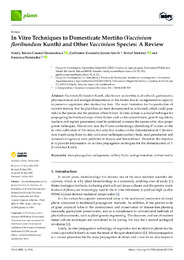Título :
In Vitro Techniques to Domesticate Mortiño (Vaccinium floribundum Kunth) and Other Vaccinium Species: A Review |
Autor :
Coronel, Nataly
Jácome, Guillermo A. 
Martinez, Rafael
Hernández, Francisca |
Editor :
MDPI |
Departamento:
Departamentos de la UMH::Producción Vegetal y Microbiología |
Fecha de publicación:
2025-05-24 |
URI :
https://hdl.handle.net/11000/37103 |
Resumen :
Vaccinium floribundum Kunth, also known as mortiño, is of cultural, gastronomic, pharmaceutical and ecological importance in the Andes due to its regenerative capacity to preserve vegetation after destructive fires. The main limitation for the production of mortiño fruits is that the plant has not been domesticated or cultivated, which could pose risks to the species and the paramos where it lives. In vitro culture is a crucial technique for propagating horticultural crops where factors such as the concentration, growth regulators, medium and explant parameters must be optimized to ensure the success of in vitro propagation techniques. This review uses the Prisma methodology, identifying 47 studies on the in vitro cultivation of Vaccinium, but only five studies on the domestication of V. floribundum Kunth using three in vitro cultivation techniques (axillary buds, seed germination and induced callogenesis) were published in Scopus and ScienceDirect. Therefore, the objective is to provide information on in vitro propagation techniques for the domestication of V. floribundum Kunth
|
Palabras clave/Materias:
Micropropagation
Callogenesis
Axillary buds
Seed germination
Culture media |
Tipo de documento :
info:eu-repo/semantics/article |
Derechos de acceso:
info:eu-repo/semantics/openAccess
Attribution-NonCommercial-NoDerivatives 4.0 Internacional |
DOI :
https://doi.org/10.3390/plants14111596 |
Publicado en:
Plants 2025, 14(11), 1596 |
Aparece en las colecciones:
Artículos - Producción vegetal y microbiología
|
 La licencia se describe como: Atribución-NonComercial-NoDerivada 4.0 Internacional.
La licencia se describe como: Atribución-NonComercial-NoDerivada 4.0 Internacional.
.png)
